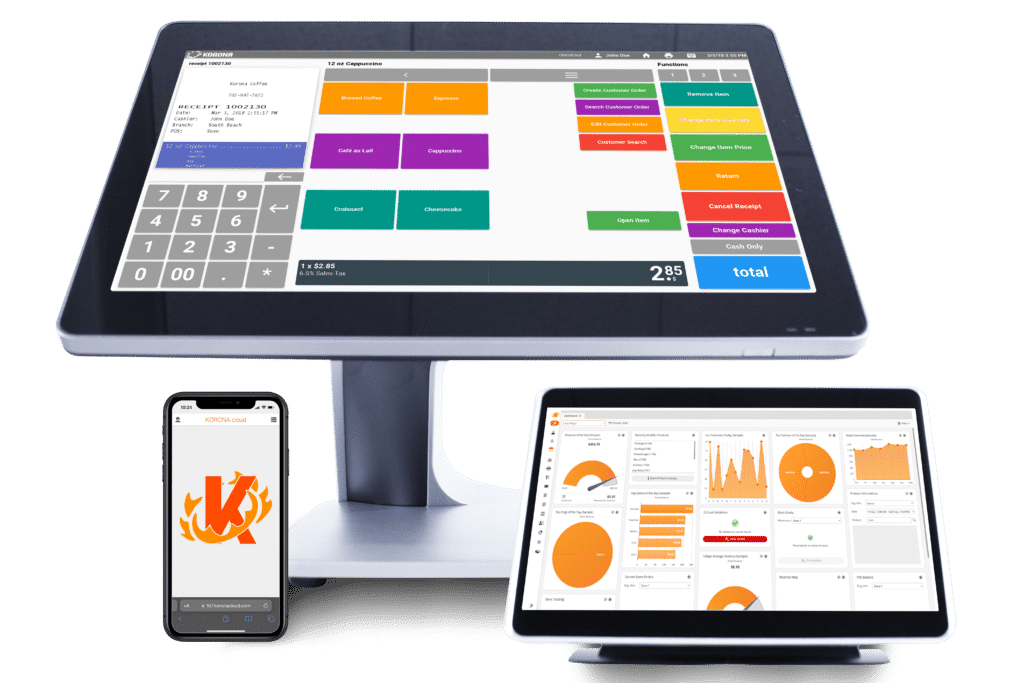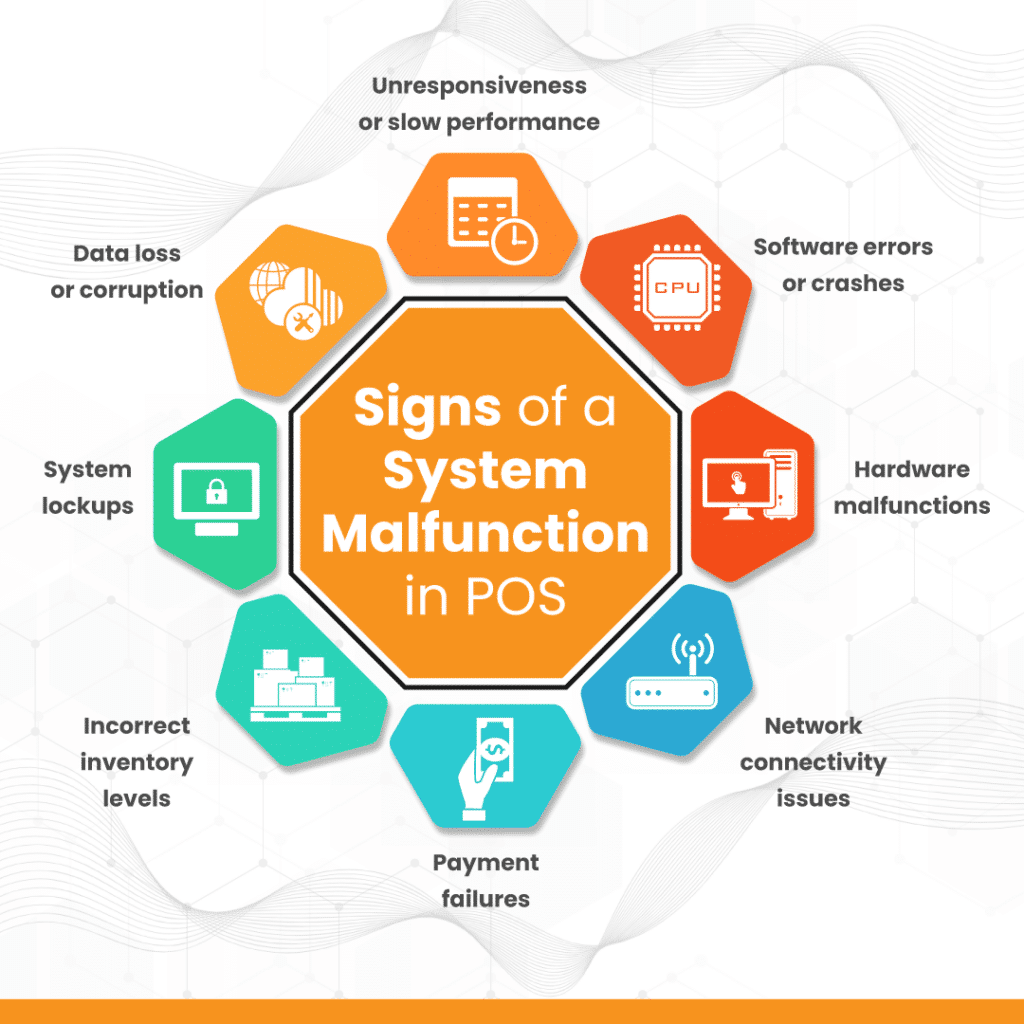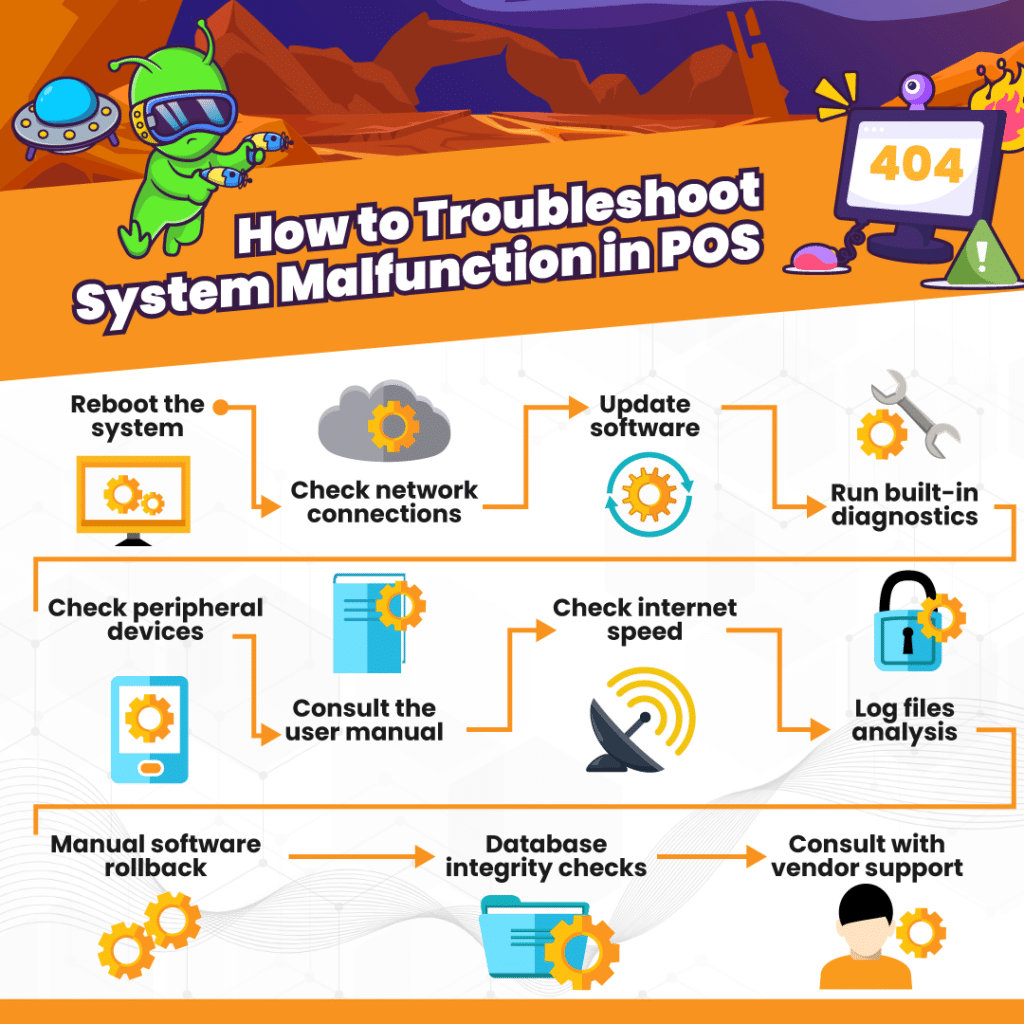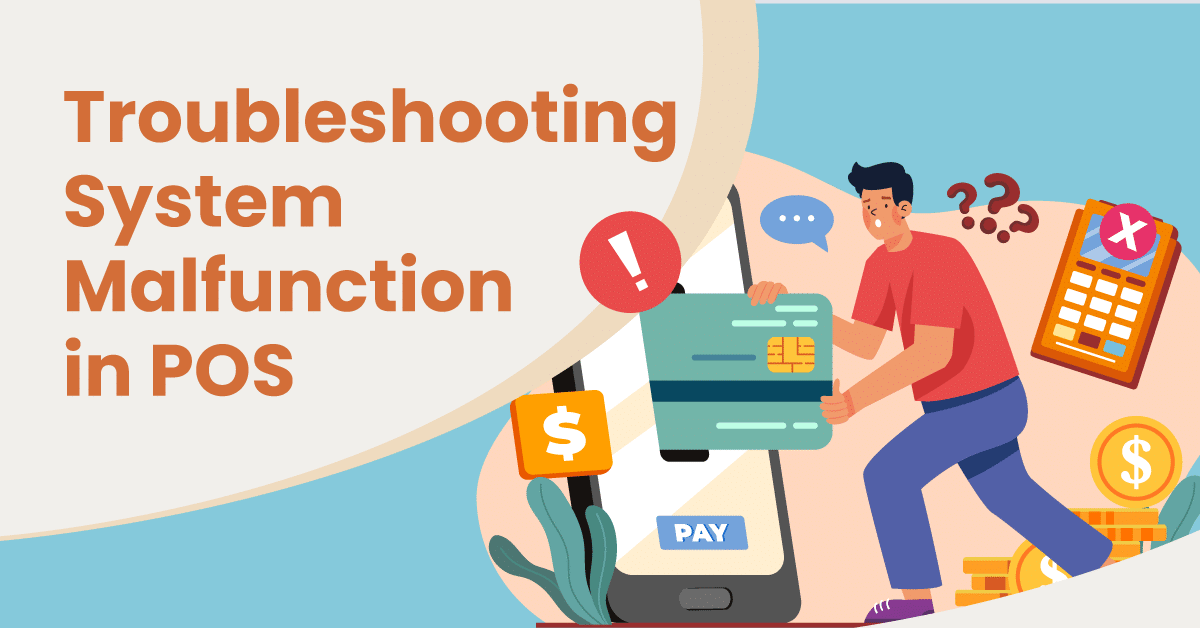
When your POS system suddenly slows down, crashes unexpectedly, or stops processing transactions altogether, it disrupts sales and frustrates customers. Point of sale (POS) system malfunctions can be a business nightmare.
Stores struggle to ring up sales efficiently, manage inventory, and analyze sales data without a fully functional POS system. Unfortunately, POS systems are complex technology that can malfunction for countless reasons. Identifying the root cause of the issue and getting your POS back up and running quickly is critical. By the end of this guide, you’ll be able to:
- Identify early indicators of problems with your point of sale system
- Implement structured troubleshooting strategies for common POS malfunctions
- Take preventative steps to reduce the likelihood of system breakdowns
Signs of a System Malfunction in POS
Identifying the early signs of a system malfunction in a retail point of sale system is crucial for maintaining business operations. Here are some of the most common indicators:
1. Unresponsiveness or slow performance
When your POS system starts to lag or becomes unresponsive, this could be a sign of software corruption, outdated hardware, or memory issues. Tasks that usually take seconds to complete might take much longer, affecting the efficiency of sales transactions. If this happens consistently, hardware upgrades or software optimization may be required.
2. Software errors or crashes
Software errors often manifest as random pop-up messages, sudden application closures, or the infamous “blue screen of death.” Software bugs, compatibility issues, or data corruption often cause these. Such errors should not be ignored, as they may indicate more significant underlying problems that can compromise sales data and customer information.
3. Hardware malfunctions
This could involve peripheral devices like printers, barcode scanners, or cash drawers not functioning as they should. For instance, if the printer fails to generate a receipt, it could be due to a driver problem or a physical hardware defect.
Failure of these components can severely impact daily operations and may necessitate immediate repairs or replacements. Hardware malfunctions sometimes manifest through screen flickers, distorted visuals, or inconsistent audio notifications. Such symptoms might imply that the hardware components of the POS system, such as the display or sound card, are failing. It’s important to recognize these signs early and address them proactively.
4. Network connectivity issues
When your POS system has trouble connecting to the internet or internal servers, this could interrupt various services like real-time inventory updates or credit card processing. This is often indicated by error messages or an inability to access certain network-dependent functionalities. The root causes can range from simple issues like loose cables to more complex ones like router failures or server downtimes.
5. Payment failures
When customers’ credit cards are not processing correctly or there are frequent transaction errors, your POS system could be at fault. This can be due to outdated software, improper integrations, or network issues.
6. Incorrect inventory levels
If you notice that the inventory levels on your POS system are not syncing correctly with your actual stock, this could indicate a system malfunction. This can occur due to software errors or, less frequently, hardware issues like a faulty scanner that misreads barcodes.
7. System lockups
This is more severe than unresponsiveness; the system completely freezes and becomes inoperable. This usually requires a hard reboot and could be symptomatic of extreme software or hardware issues, including overheating components or low disk space.
8. Data loss or corruption
If transaction histories, customer details, or other vital information suddenly go missing or become corrupted, it’s a serious sign that your POS system is malfunctioning. This can be due to hard drive failure, malware attacks, or severe software bugs and should be addressed immediately to prevent further loss and potential legal issues.

How to Troubleshoot System Malfunction in POS
Troubleshooting a malfunctioning POS system minimizes downtime and maintains customer satisfaction. Here are troubleshooting techniques to consider:
Step 1: Reboot the system
Often, minor glitches can be resolved by simply restarting the POS terminal. Ensure all work is saved before doing so to prevent data loss.
Step 2: Check network connections
Verify that all cables, routers, and switches are correctly plugged in and functioning. Reconnecting the WiFi or re-plugging ethernet cables will usually resolve basic connectivity issues.
Step 3: Update software
Outdated software can lead to malfunctions. Ensure your POS system runs the latest software version, and update it if necessary. However, some POS systems update automatically, eliminating the need for manual software updates.
Step 4: Run built-in diagnostics
Many POS systems have built-in diagnostic tools. Use these to identify any apparent issues.
Step 5: Check peripheral devices
Test printers, scanners, and other devices to see if they function. Swap out malfunctioning devices with working ones to confirm the issue.
Step 6: Consult the user manual
Sometimes, the answer might be in the documentation that comes with your hardware or software. Look for troubleshooting sections that may describe solutions to your specific issue.
Step 7: Check internet speed
Slow or unstable internet can cause transaction failures and slow performance. Run a speed test and contact your ISP if the speed is less than needed.
Step 8: Log files analysis
Check system log files to find error messages or codes. This can provide clues to more complicated issues and is often useful for tech support.
Step 9: Manual software rollback
If a recent software update caused the malfunction, consider rolling the software back to a previous version to avoid complete loss. Ensure you back up data before doing this.
Step 10: Database integrity checks
Some POS systems allow for a database integrity check, which can identify and sometimes automatically correct data corruption issues.
Step 11: Consult with vendor support
When in doubt, contacting vendor tech support is often the best course of action. They may have insights or diagnostic tools specific to your POS system. Contact your POS system provider for assistance if you have exhausted the above troubleshooting steps. They can help you to diagnose and resolve the problem.
By employing these troubleshooting techniques, store operators can diagnose and often resolve issues that can interfere with the regular operation of their POS systems. Note that those with appropriate technical expertise should only perform some advanced techniques.

Preventive Measures And Troubleshooting in The Event of POS System Malfunctions
Here are some preventive measures to avoid POS system malfunctions:
- Regularly update the POS software and firmware. This will help to fix any known bugs or security vulnerabilities that could cause problems. The best cloud-based POS systems typically come with automatic updates.
- Use a surge protector to protect the POS system from power surges. Power surges can damage the POS system and cause it to malfunction.
- Keep the POS system clean and free of dust. Dust can build up and cause the POS system to overheat, which will make any hardware run slower or even shut down.
- Avoid placing the POS system in direct sunlight or near heat sources. Heat can also cause the POS system to overheat and malfunction.
- Back up the POS data regularly. This will help to protect your data in the event of a POS system malfunction.
Troubleshooting System Malfunction With KORONA POS
There may be instances when you cannot resolve all troubleshooting issues, requiring you to contact your POS provider for support. That’s why it’s crucial to have a POS provider that offers reliable support that can help you troubleshoot any problems quickly and efficiently.
KORONA POS is one such provider. With KORONA POS, you have access to a team of experienced and knowledgeable support technicians available 24/7 to help you with any issues you may be experiencing.
Here are some specific ways that a support team like this can help you troubleshoot your POS system malfunction:
- Remote support: Support technicians can remotely connect to your POS system to diagnose and resolve problems. This can save you time and hassle, as you do not need to send your POS system to a repair center. You can contact KORONA POS through phone calls, emails, or chat.
- On-site support: In some cases, support technicians can come to your store to provide on-site support. This is especially helpful for complex problems that cannot be resolved remotely.
- Knowledge base: Most POS providers have a comprehensive manual containing information on troubleshooting common problems. These typically include a user manual, training videos, and step-by-step guides.
- Personalized service: Support technicians should take the time to understand your specific needs and provide you with the best possible support. Find a POS service that is responsive and friendly.
“What I like about KORONA POS is the fact that we call customer support and we get answered immediately…it’s been very simple to train my employees with this POS system.
– Roger, The Cove on Harbor”
Even the most popular POS providers don’t always offer quality customer support. Call different support lines to see how fast someone responds. Look at product reviews on third-party sites. Ask other retailers how they feel about their POS support. It’s important. After all, even a few hours of downtime be catastrophic for a business.
Do you have trouble getting your POS customer service on the phone?
KORONA POS offers 24/7 phone, chat, and email support. Call us now at 833.200.0213 to see for yourself.
In Conclusion: Troubleshooting System Malfunction in POS
POS system malfunctions can cost retailers hours of productivity and thousands of dollars in lost revenue. Stores can drastically reduce downtime and disruption by learning to identify issues and methodically troubleshoot them promptly. While complex problems may require professional assistance, business owners can resolve many POS errors with the proper knowledge.
This guide outlines actionable tips to diagnose and address a wide range of common POS malfunctions. By following preventive measures and establishing support channels in advance, retailers can tackle POS issues swiftly.
And with reliable customer service, businesses can know that help is available if something goes wrong. Keeping your POS system in optimal working order ensures excellent customer experiences and uninterrupted sales. Are you considering a switch from your current POS system? Click the button below to learn more about KORONA POS and determine if it’s the right fit for your business.













